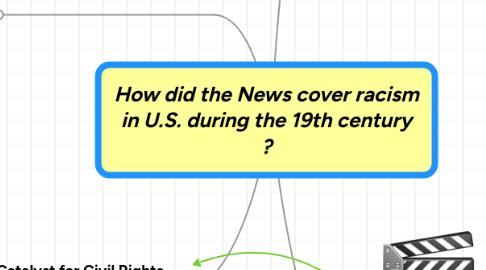
1. Does racism still exist?
1.1. "Threats against President Obama have increased by 400% since G. W. Bush left office, the highest numbers on record."
1.2. Rodney King beating and Trial
1.3. The description of black people "looting" stores, while white people were "finding" food was simply racist and provoked many people to speak out
2. emmit till
2.1. Overall Information
2.1.1. born: July 25, 1941 in Chicago, Illionis
2.1.2. murdered: August 28, 1955 in Mississippi Delta
2.1.3. Ethnicity= African-American
2.2. The Murderer
2.2.1. J.W. Milam
2.2.1.1. half brother of Roy Bryant
2.2.2. Roy Bryant
2.2.2.1. Husband of "white woman"
2.3. Scenario
2.3.1. provoking incident: reportedly flirting with a white woman
2.3.2. early morning hours—between 2:00 and 3:30—on Sunday Till gets kidnapped
2.3.3. transported him to a barn, beat him and gouged out one eye, before shooting him through the head
2.3.4. disposing of his body in the Tallahatchie River, weighting it with a 70-pound (32 kg) cotton gin fan tied around his neck
2.3.5. discovered and retrieved from the river three days later
2.3.6. Tills Mother insisted on a public funeral and open casket, to show the cruelty
2.3.7. jury acquitted both defendants after a 67-minute deliberation
2.4. News Reaction
2.4.1. were furious about the verdict and critical of American society
2.4.2. October 1955, the Jackson Daily News reported facts about Till's father that had been suppressed by the U.S. military.
2.4.2.1. while serving in Italy, Louis Till raped two women and killed a third
3. reporting on the Ku Klux Klan
3.1. year membership 1920 4,000,000 1924 6,000,000 1930 30,000 1970 2,000 2000 3,000
3.2. summer 1964 Mr. Goodman, Mr. Schwerner, two white Northerners and Mr. Chaney, a black Mississippian, converged in Neshoba County.
3.2.1. On June 21, they disappeared.
3.3. Pulitzer Price
3.3.1. 1953: Whiteville News Reporter, a semi-weekly North Carolina newspaper, and Tabor City Tribune, a weekly North Carolina newspaper, "for their successful campaign against the Ku Klux Klan, waged on their own doorstep at the risk of economic loss and personal danger, culminating in the conviction of over one hundred Klansmen and an end to terrorism in their communities."
3.3.2. 1926: Columbus Enquirer Sun, "for the service which it rendered in its brave and energetic fight against the Ku Klux Klan; against the enactment of a law barring the teaching of evolution; against dishonest and incompetent public officials and for justice to the Negro and against lynching."
4. Catalyst for Civil Rights
4.1. Till's case became emblematic of disparity of justice for blacks in South
4.2. 1955, the Chicago Defender urged their readers to react to acquittal by voting in large numbers
4.3. The NAACP asked Mamie Till Bradley to tour the country relating the events of her son
4.3.1. It was one of the most successful fundraising campaigns the NAACP had ever known
